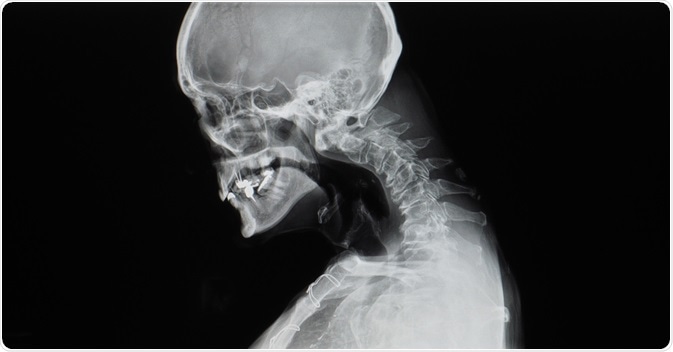Kyphosis is a term used to describe marked curvature of the spine in the sagittal plane that results in an abnormally rounded back. A certain degree of kyphosis is normally present at the thoracic and sacral spinal segments. If the curve of a person's thoracic spine exceeds 40 to 45 degrees, it is considered abnormal.

Image Credit: Yok_onepiece / Shutterstock.com
Degenerative disc diseases, inflammation, trauma, developmental anomalies, and infectious diseases are the known causes of kyphosis. It can be generally divided into two types including low degree kyphosis, such as postural roundback, and high degree kyphosis, which encompasses health conditions like Scheuermann's disease, angular gibbus deformity, congenital kyphosis, and Pott disease. Kyphosis may also develop due to muscular and neuromuscular diseases.
Postural kyphosis
Postural kyphosis (round back) is a flexible kyphosis that is typically not associated with pain. Slouching during childhood affects the normal development of the spine, causing it to curve forward. This type of kyphosis is often accompanied by hyperlordosis of the lumbar spine, which is an excessive curvature of the lower spine in the opposite direction.
Postural kyphosis corrects itself when lying down on a horizontal surface, or when the spine is hyper-extended. No vertebral abnormalities are seen on X-rays, as this type of kyphosis is not caused by a deformity or structural damage. In fact, the condition is rather easily corrected with education about proper posture, strengthening the back muscles, and retraining on how to sit and stand correctly.
Scheuermann's kyphosis
Scheuermann's kyphosis, or Scheuermann's disease, is defined as thoracic kyphosis of more than 45 degrees with greater than 5 degrees of anterior wedging in 3 adjacent vertebrae. It represents the most common severe form of thoracic kyphosis in adolescence, with a reported prevalence of 1 to 8%. Schmorl's nodes, which are small herniations of intervertebral discs are also present at the ends of the affected vertebrae.
The biggest difference between this condition and postural kyphosis is that a patient suffering from Scheuermann's kyphosis cannot consciously correct their posture due to the rigidity of the curve. Although the exact cause remains unclear, there are many possible theories about its development. Most researchers consider that the process is started by some sort of damage to the growth area of the vertebrae, resulting in abnormal growth and subsequent excessive kyphosis.
Congenital kyphosis
Congenital kyphosis refers to an inherited abnormal development of the spine when the individual is born with some sort of defect that can lead to a severe abnormal kyphosis.
This type of kyphosis also represents the most common non-traumatic and non-infectious cause of paraplegia. There is a strong association of these congenital abnormalities with the body's urinary tract, which can be helpful in diagnosing this condition.
Pott's kyphosis
Spinal tuberculosis, which is also known as Pott’s kyphosis, is the most common cause of a kyphotic spinal deformity in large parts of the world. Tuberculosis has a preference for the anterior segment of the vertebral column in more than 90% of the patients. The most severe deformities are seen in children involving the thoracolumbar spine. Such kyphosis can progress even after the healing of the spinal infection.
Injury of the spine can result in both progressive kyphosis and nerve problems. When there is a vertebral fracture in the thoracic or lumbar spine, in 90% of cases, some degree of kyphosis will ensue. This condition can also arise following surgery of the spine due to other indications. Degeneration of the lumbar spine results in a gradual development of kyphosis.
Kyphosis Symptoms
Diagnosis of kyphosis
Taking a patient's history is a first step in making an accurate diagnosis and ruling out other conditions, as early detection of kyphosis is pivotal for successful treatment. The clinical interview is used to collect important information, such as the date of onset of the deformity, occurrence of pain, eventual progression over time, any treatments used so far, as well as other health problems in the patient or family.
During the exam, the healthcare provider will try to get a proper understanding of the spinal curve and the way it is affecting the patient. The spine should be assessed from the sides, front, and back after the patient is undressed. If the deformity disappears completely when the child is asked to stand up, the most likely diagnosis is postural kyphosis.
Usually, full-length anteroposterior and lateral radiographs are ordered to allow for proper visualization of the spinal structure. Computerized tomography (CT) of the spine provides supplemental information on eventual bone abnormalities predating or caused by kyphosis. With magnetic resonance imaging (MRI), it is possible to assess the junction of the spinal joints and determine if there is an impingement on the spinal canal of bone structures.
A detailed neurological evaluation is often obligatory. Special attention should be given to assess deep tendon reflexes, superficial abdominal reflexes, and the eventual presence of hypertonia. Other specific investigations may be attained when needed, such as lung function testing, a spinal cord arteriogram, an intradermal tuberculin test, ultrasonography of the kidneys, or echocardiography, to name a few.
References
Further Reading
Last Updated: Feb 17, 2023